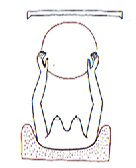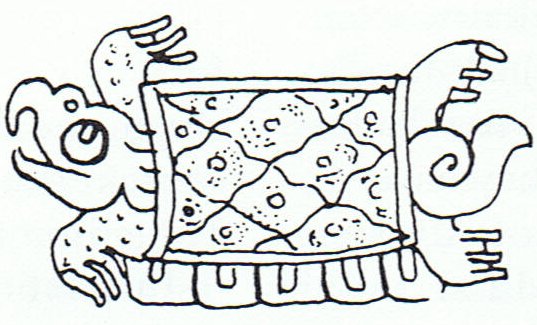54. The C text continues with honu glyphs past Polaris and past the end of side a until Hamal was reached:
From the equinox in ºSeptember 22 (265) to Hamal close to the Full Moon in ºOctober 16 (289) in the following year there were 289 - 265 + 366 = 390 (= 30 * 13 = 15 * 26) days = 396 (Cb1-6) - 6 (Ca1-6). This number could have alluded to 780:
779.96 = approximatively 780 = 414 + 366 = 2 * 390. The turtle (honu) in Cb1-2 ought to be an indication of how the upper shell of the Earth Turtle (Pawahtun) contined beyond Polaris and Sheratan:
... An iconographic study by Jeff Kowalski suggests a cosmological layout for the Nunnery. The higher placement of the North Building, with its 13 exterior doorways (reflecting the 13 layers of heaven), and the celestial serpents surmounting the huts identify it with the celestial sphere. The iconography of the West Building, with 7 exterior doorways (7 is the mystic number of the earth's surface), and figures of Pawahtun - the earth god as a turtle - indicate this to be the Middleworld, the place of the sun's descent into the Underworld. The East Building has mosaic elements reflecting the old war cult of Teotihuacan, where tradition had it that the sun was born; thus, this may also be Middleworld, the place of the rising sun. Finally, the South Building has 9 exterior doorways (the Underworld or Xibalba had 9 layers), and has the lowest placement in the compex; it thus seems to be associated with death and the nether regions ... At the equinoxes the Sun was passing across from one hemisphere to the other, and this place was neither high up among the birds nor far down among the fishes - it was in the world between (ki roto).
South of the equator the crust of Mother Earth was apparently penetrated by a Tree (rakau) in day 295 (= 10 * 29½).
This 'earth turtle' was also mentioned before the Pleiades:
After having secured her offspring, buried them in the sands of the long beach, she could then return back into the sea:
Her offspring had evidently been delivered by way of Bharani:
... They all sat down and rested [on the plain of Oromanga], when suddenly they saw that a turtle had reached the shore and had crawled up on the beach. He [Ira] looked at it and said, 'Hey, you! The turtle has come on land!' He said, 'Let's go! Let's go back to the shore.' They all went to pick up the turtle. Ira was the first one to try to lift the turtle - but she didn't move. Then Raparenga said, 'You do not have the necessary ability. Get out of my way so that I can have a try!' Raparenga stepped up and tried to lift the turtle - but Raparenga could not move her. Now you spoke, Kuukuu: 'You don't have the necessary ability, but I shall move this turtle. Get out of my way!' Kuukuu stepped up, picked up the turtle, using all his strength. After he had lifted the turtle a little bit, he pushed her up farther. No sooner had he pushed her up and lifted her completely off the ground when she struck Kuukuu with one fin. She struck downward and broke Kuukuu's spine.The turtle got up, went back into the (sea) water, and swam away. All the kinsmen spoke to you (i.e. Kuukuu): 'Even you did not prevail against the turtle!' They put the injured Kuukuu on a stretcher and carried him inland. They prepared a soft bed for him in the cave and let him rest there. They stayed there, rested, and lamented the severely injured Kuukuu. Kuukuu said, 'Promise me, my friends, that you will not abandon me!' They all replied, 'We could never abandon you!' They stayed there twenty-seven days in Oromanga. Everytime Kuukuu asked, 'Where are you, friends?' they immediately replied in one voice, 'Here we are!' They all sat down and thought. They had an idea and Ira spoke, 'Hey, you! Bring the round stones (from the shore) and pile them into six heaps of stones!' One of the youths said to Ira, 'Why do we want heaps of stone?' Ira replied, 'So that we can all ask the stones to do something.' They took (the material) for the stone heaps (pipi horeko) and piled up six heaps of stone at the outer edge of the cave. Then they all said to the stone heaps, 'Whenever he calls, whenever he calls for us, let your voices rush (to him) instead of the six (of us) (i.e., the six stone heaps are supposed to be substitutes for the youths). They all drew back to profit (from the deception) (? ki honui) and listened. A short while later, Kuukuu called. As soon as he had asked, 'Where are you?' the voices of the stone heaps replied, 'Here we are!' All (the youths) said, 'Hey, you! That was well done!' ...
|
||||||||||||||||||||||||||||||||||||||||||||||||||||||||||||||||||||||||||||||||||||||||||||||||||||||||||||||||||||||||||||||||||||||||||||||||||||||||||||||||||||||||||||||||||||||||||||||||||||||||||||||||||||||||||||||||||||||||||||||||||||||||||||||||||||||||||||||||||||||||||||||||||||||||||||||||||||||||||||||||||||||||||||||||||||||||||||||||||||||||||||||||||||||||||||||||||||||||||||||||||||||||||||||||||||||||||||||||||||||||||||||||||||||||||||||||||||||||||||||||||||||||||||||||||||||||||||||||||||||||||||||||||||||||||||||||||||||||||||||||||||||||||||||||||||||||||||||||||||||||































